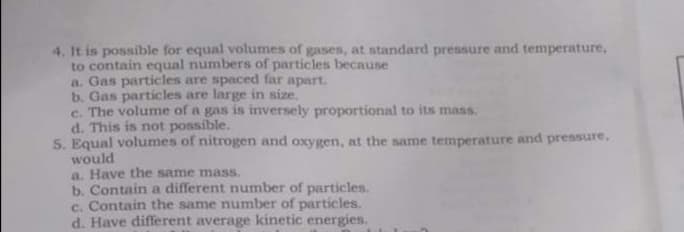4. It is possible for equal volumes of gases, at standard pressure and temperature, to contain equal numbers of particles because a. Gas particles are spaced far apart. b. Gas particles are large in size. e. The volume of a gas is inversely proportional to its mass. d. This is not possible. 5. Equal volumes of nitrogen and oxygen, at the same temperature and pressure, would a. Have the same mass. b. Contain a different number of particles. c. Contain the same number of particles. d. Have different average kinetic energies.
4. It is possible for equal volumes of gases, at standard pressure and temperature, to contain equal numbers of particles because a. Gas particles are spaced far apart. b. Gas particles are large in size. e. The volume of a gas is inversely proportional to its mass. d. This is not possible. 5. Equal volumes of nitrogen and oxygen, at the same temperature and pressure, would a. Have the same mass. b. Contain a different number of particles. c. Contain the same number of particles. d. Have different average kinetic energies.
Chapter6: The States Of Matter
Section: Chapter Questions
Problem 6.103E
Related questions
Question
number 5 only

Transcribed Image Text:4. It is possible for equal volumes of gases, at standard pressure and temperature,
to contain equal numbers of particles because
a. Gas particles are spaced far apart.
b. Gas particles are large in size.
e. The volume of a gas is inversely proportional to its mass.
d. This is not possible.
5. Equal volumes of nitrogen and oxygen, at the same temperature and pressure,
would
a. Have the same mass.
b. Contain a different number of particles.
c. Contain the same number of particles.
d. Have different average kinetic energies.
Expert Solution
This question has been solved!
Explore an expertly crafted, step-by-step solution for a thorough understanding of key concepts.
This is a popular solution!
Trending now
This is a popular solution!
Step by step
Solved in 4 steps

Knowledge Booster
Learn more about
Need a deep-dive on the concept behind this application? Look no further. Learn more about this topic, chemistry and related others by exploring similar questions and additional content below.Recommended textbooks for you


Chemistry for Today: General, Organic, and Bioche…
Chemistry
ISBN:
9781305960060
Author:
Spencer L. Seager, Michael R. Slabaugh, Maren S. Hansen
Publisher:
Cengage Learning

Living By Chemistry: First Edition Textbook
Chemistry
ISBN:
9781559539418
Author:
Angelica Stacy
Publisher:
MAC HIGHER


Chemistry for Today: General, Organic, and Bioche…
Chemistry
ISBN:
9781305960060
Author:
Spencer L. Seager, Michael R. Slabaugh, Maren S. Hansen
Publisher:
Cengage Learning

Living By Chemistry: First Edition Textbook
Chemistry
ISBN:
9781559539418
Author:
Angelica Stacy
Publisher:
MAC HIGHER

Chemistry: An Atoms First Approach
Chemistry
ISBN:
9781305079243
Author:
Steven S. Zumdahl, Susan A. Zumdahl
Publisher:
Cengage Learning

Chemistry
Chemistry
ISBN:
9781305957404
Author:
Steven S. Zumdahl, Susan A. Zumdahl, Donald J. DeCoste
Publisher:
Cengage Learning
